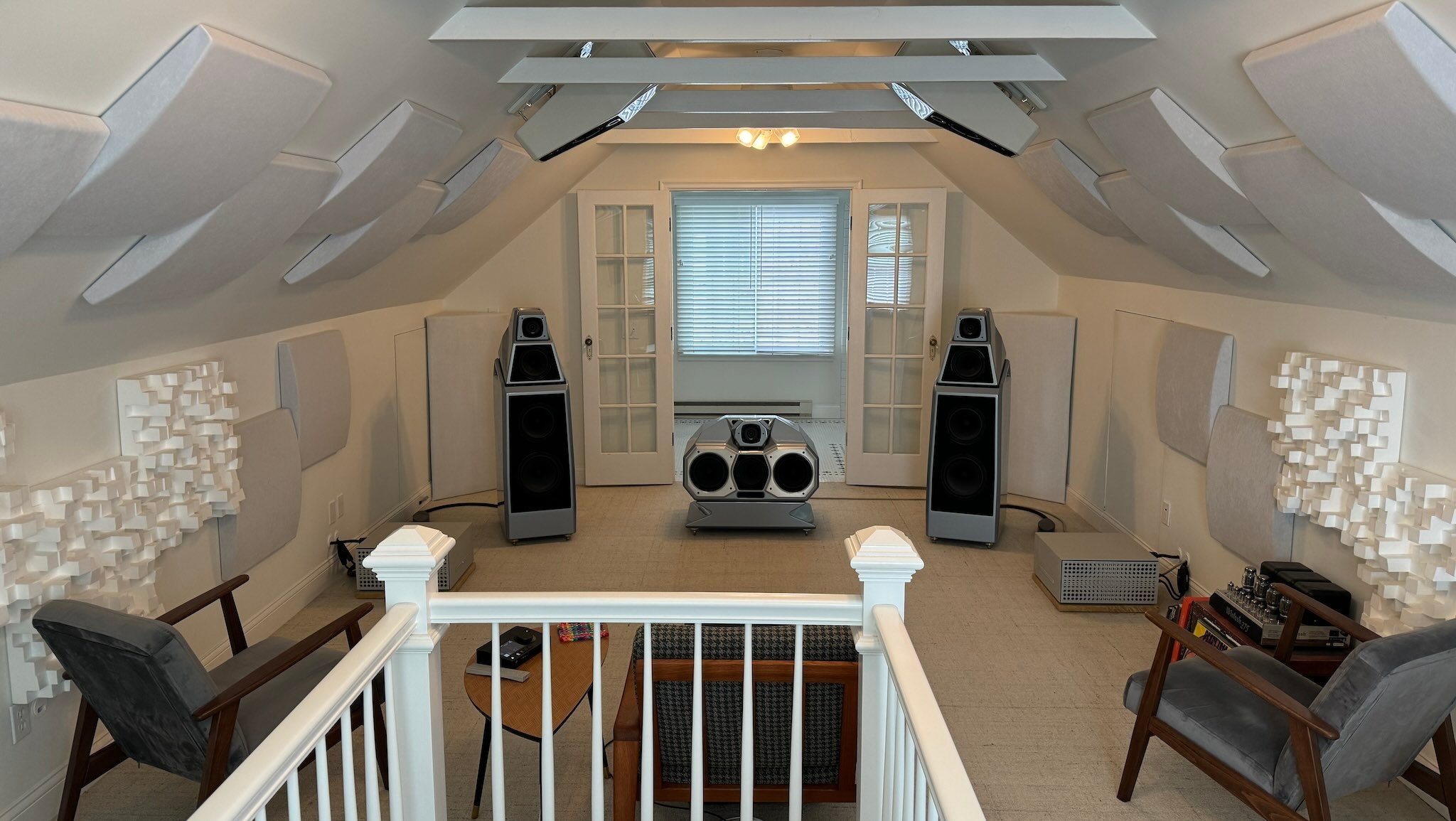About The Computer Audiophile

Retained
-
Member Title
Founder Audiophile Style
Personal Information
-
Location
Minneapolis, MN
Recent Profile Visitors
320813 profile views
-
-

My 5 favourite Atmos albums
The Computer Audiophile replied to Magnificat's topic in Immersive Audio
Now you’re speaking my language :~) That Magnificat is truly special. I honestly didn’t care for the album until I heard the immersive version. Now, I love it! My current favorite and what I think is the best immersive release this year, is Pearl Jam’s Dark Matter. Also on my list is A Shade of Blue from Tsuyoshi Yamamoto Trio. If you haven’t already done so, check out the immersive releases from TRPTK - https://trptk.com/product-category/spatial-audio-downloads/ Also, I’d love to know what @JoeWhip’s favorites are. -

Anyone else with modest immersive setup?
The Computer Audiophile replied to Magnificat's topic in Immersive Audio
The gear is just a tool, to bring us closer to our favorite music. There are people here with systems all along the continuum. As long as there’s music coming out of the speakers, it’s all good 🙂 Thanks for joining the community. -
Audio: Listen to this article. I was inspired to use the title of this article, Improve Your Audio System - Tonight!, by a grocery store tabloid I saw many years ago. It was so preposterous that I never forgot it. The big headline on the tabloid was, “Lose Ten Pounds - Tonight!” However, the title to my article is 100% true. The vast majority of audiophiles can improve their audio systems by a large margin, tonight. On the other hand, the keys that open the gates to heaven, also open the gates to hell. Many audiophiles, myself included, should reach out to a professional, who can improve their system immensely, tonight. OK, reach out to a professional tonight, but don’t expect results tonight. What is this improvement about which I’m taking? State of the art room correction. I can’t stress this enough. There’s room correction, and there’s state of the art room correction. Given the time and money we spend on this hobby, to squeeze even more enjoyment out of our favorite music, we should shoot for the best when it comes to room correction. The differences between good and state of the art can be humongous. As a former hater of DSP and all room correction, I know what many members of this community are likely thinking. All the geeks remember in 1998 when Linux would be on every desktop by Y2K, and all the more traditional audiophiles remember when the latest Class D amp had finally dethroned the best Class A had to offer. Neither of those well-hyped proclamations were realistic, even if they were wholeheartedly believed by the proclaimers. As The Who said, we won’t get fooled again. I understand why we won’t soon forget these somewhat aspirational claims and why we remain skeptical about room correction. We’ve been there and done that. Or so we thought. Many of us have heard good room correction, some of us have heard bad room correction, but few of us have heard state of the art room correction, in the hands of a professional. In fact, just today I received the April edition of the Merrill Audio Newsletter, in which Editor Alan Hyman and Mark Block wrote a section titled “Measuring my System and Room.” I like reading this newsletter, as it’s usually very different from anything I cover here on Audiophile Style. In this April letter, the author states, “One thing I don’t use REW for is room correction. There lies madness (for me). Room correction only works for low frequencies, and even there it can’t fix standing-wave suckouts. I prefer to get the setup as good as possible and then let the system do its thing.” I place absolutely zero blame on Alan and Mark for writing that incorrect statement, and believe that they truly believe it’s accurate and they are doing their best to help readers of the newsletter. For that I applaud them. They are helping people get more out of their audio systems, and not using room correction for this exercise. In fact Mark says, “Over time, I’ve learned just enough to get myself into trouble. Humility about my expertise must be practiced religiously. I limit myself to interpreting frequency responses for specific purposes: blending in subwoofers; placing the speakers in the room for best tonal balance; adjusting toe-in for better in-room response; confirming or falsifying problems I think I hear.” I’m not sure I’ve met Mark, but I like him already. The more you know, the more you know you don’t know. The more I’ve learned about room correction, the more I’ve learned I don’t know about room correction. This is why I leave it to a professional. Like Mark, I know enough to get myself in trouble, and I’ve done that a few times. It’s ugly. State of the art room correction is nothing like its predecessors. Sure, it stands on the shoulders of that which came before it, but the results take audio systems to new heights only dreamt about by previous product designers. We are no longer limited by weak hardware, expensive FPGAs, point and click wizards, and lack of options. Today, state of the art room correction can take advantage of endless computing power, even though it isn’t needed in most cases, and measurement applications that are far more advanced than anything previously available. Geek’s Note: This is an excerpt from my immersive audio DSP article, but the facts are valid for mono, stereo, multichannel, and immersive audio. It starts with 65,536 tap FIR filters. This alone is well beyond the capabilities of traditional processors. As one listens to higher sample rates, the filter can be upsampled to several hundred thousand or over one million taps automatically. This ensures the frequency resolution of the FIR filter stays the same when the sample rate increases and is a distinction with a major difference. Frequency resolution = fs / N where fs is the sample rate and N is the number of filter taps. A 65,536 tap FIR filter at 48 kHz (Atmos is currently all released at 48 kHz) has a frequency resolution of 48000/65536 = 0.732 Hz. The frequency range spans 0Hz to 24 kHz. Thinking of an FIR filter as a graphic equalizer: 24000/0.732 = 32,768 sliders for an FIR equalizer. This FIR real world example has 1000 times the frequency resolution of a 1/3 octave equalizer. In addition a rough rule of thumb is that the effective low frequency limit of the filter is to multiply the frequency resolution by 3, which is 3 x 0.732 Hz = 2.2 Hz. A 65,536 tap FIR filter running on a computer can control frequencies down to 2.2 Hz. I’ve spent the last several years using state of the art room correction in my two channel and twelve channel systems. I’ve also read as much as I can comprehend about the topic and sought help from experts in the field. The bottom line for me is that the technology must produce a result that I want. I don’t care if it’s really advanced, powerful, and uses a million-bit processing to make my room measure perfectly. If I can’t hear the texture of the drum head when Jimmy Cobb brushes it, can’t feel the power of Marcus Miller’s bass, or be floored by the percussive transients of a full orchestral crescendo, then DSP isn’t for me. Fortunately, because of state of the art room correction, I can hear all of this even better. My room is no longer the loudest instrument in the Miles Davis Quintet. Surely there must be a huge cost and long lead time to obtain such state of the art room correction. Nope, it’s all available tonight, for those with the requisite skills. For everyone else like me, cut right to the chase by hiring Mitch Barnett of Accurate Sound ( @mitchco ). His bespoke service is tailored to you. Yes, your system, your room, and most importantly, your taste. Heck, if you want a few different room correction profiles, that you can enable with the click of a mouse or tap of the finger on an iPad, Mitch can easily provide that. Mitch has worked on literally hundreds of rooms, wrote a book about room correction, and offered a master class video for free. For the ambitious among us, who already own a measurement microphone, and want to dive into taking measurements, I advise caution. When I first did this, I was bummed out by what I saw. Even though what I heard in my room didn’t sound as bad as the measurements looked, the visual sight of a frequency response mountain range with large peaks and valleys was disheartening. Plus, there was nothing I could do to make it better. Everything I tried in the free REW app made it worse. I had no idea what I was doing, and it showed. Take a brief moment to think about the field you work in or think about the best people in the business, any business. Those people usually eat, sleep, and breathe the profession, and / or have so much experience they laugh at putting in 10,000 hours. Now, think about your audio system and the incredibly high level of performance you’re seeking. Can you see why I recommend bringing in the big guns, to obtain state of the art room correction performance? State of the art involves both technology and a professional who knows what s/he is doing. Getting back to the raison d'etre for this article, my dream is that everyone can read it with curiosity and hope that there’s something available that will make their audio systems and music sound even better. This is absolutely NOT an article meant to drive a wedge between those with and those without room correction. Such an article serves nobody. I believe so strongly in room correction that I can’t write about it enough. It’s based on science, its implementation is an art, it’s inexpensive, and it enables audio systems to deliver what we all want, an even better musical experience. Reach out to a professional tonight. It’s the best money you’ll spend on HiFi this decade. About the author - https://audiophile.style/about Author's Complete Audio System Details with Measurements - https://audiophile.style/system
-
Saw it and got jealous. I’ll be in Munich when they play MN.
-

The "Official" Aurender Discussion Thread
The Computer Audiophile replied to rwwjr44's topic in Music Servers
N100 would be a good move. Don’t discount Aurender support either. Something goes wrong, they’ll connect from Korea or the US and fix it, while you sleep. -
I’m all for expressing opinions, and I usually like reading John’s. This specific missive came off differently to me though. I felt like, just make the best stuff you can and sell it on how good you think it is rather than write some strange post about a bunch of other stuff you don’t like or agree with.
-
Perhaps he’s selling something with at least 115 dB SNR :~)
-
Good questions! I use the Anubis now for D to D, like a digital preamp, so DSD isn’t really an option. The volume control doesn’t work on DSD in the digital domain, and I don’t want to listen at full volume. Ideally the Anubis would control the volume of the HAPI, then DSD would be a real thing for me.















